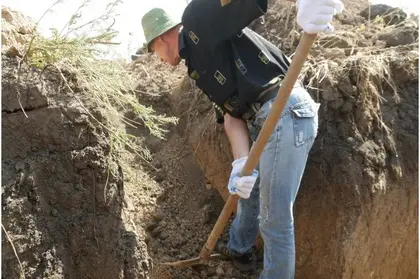This important checkpoint is set on the
road that leads from the town of Novoazovsk, which had been taken
over by the Russian troops. The National Guard who man it split the
volunteers into two groups and showed them the places where they
should dig trenches on both sides of the road.
The previous day, some 2,000 people
rallied in city center against the Russian invasion, and the most
active of them decided to come and help the Ukrainian troops to
defend their city from an anticipated invasion by the Russians.
JOIN US ON TELEGRAM
Follow our coverage of the war on the @Kyivpost_official.
“You can see for
yourself that they really want a full-scale war. They don’t even
hide it anymore,” said Oleksandr Shalatanov, a 25-year-old civil
activist. He added that his friend who lives in Novoazovsk said that
the soldiers who entered the city on Aug. 27 were definitely
Russian, but had no insignia. The same tactic was used during
annexation of Crimea in March, which Russian President Vladimir Putin
later admitted. Despite being half-Russian, Shalatanov said he
considered the Russian army to be invaders.
“It so happens
that just 40 kilometers away from us there is an enemy,” said
Svitlana, a factory worker in her 50s, who was afraid to give her
last name to the media. She was not afraid to dig the trenches,
though, holding on tight to her spade.
A self-made poster reading “Help the
army – defend yourself” hung by the checkpoint, which has been
closed for civilian cars in the last few days. But when a car with
armed men from the Dnipro 1 battalion passed the checkpoint on
the way to Novoazovsk, people cheered the fighters heading to the
front lines.
These new trenches dug by civilians
would probably make little difference for Russian tanks in
Novoazovsk, which number between several dozen and over a hundred,
according to various estimates.
“We need tanks, heavy artillery to
restrain the attack here,” said one of the soldiers at the check
point, a young man from Mykolayiv city. He refused to give his name
because he is not authorized to talk to the media.

The residents know that their effort
would not hold the Russian army, but they still think it’s better to
make some effort “instead of sitting at home and getting crazy over
the news,” said Maria Podybailo, coordinator of Novy Mariupol, a
local volunteer group of more than 100 activists who help the
Ukrainian forces.
There are bullet-proof vests, helmets,
jars of preserved food and medications piled in the office of this
organization that was set up in late March. A group of women make
masking nets.
There are three mobile groups of
volunteers that take food and medication to the Ukrainian checkpoints
around Mariupol every day. This group also handles the wounded
fighters, finding them doctors and medicines, contacting their
relatives and handling their transportation out of the war zone.
But with the Russian threat approaching
the city, activists also created a Mariupol battalion of territorial
defense. “We did it in case if their (Russian) troops enter here,
to train people to carry out sabotages,” said Podybailo, a blond
woman wearing camouflage. Her actual job is to teach political
science at the local university. She added that there are about 300
fighters at this newly created battalion.
But people of Mariupol are actually
split over whether to support or resist the Russian troops. Many have
preferred to simply leave the city. There were long lines of people
wanting to leave Mariupol at the local bus stop in the morning, the
local web-site Novosti Mariupolia reported. The Kyiv Post saw three
buses with children heading from the summer camps located in the
outskirts of Mariupol on the way to Novoazovsk.
But the pro-Ukrainian activists realize
that they are a minority in Mariupol, where fierce fights between
pro-Russian separatists and Ukrainian battalions lead to several
deaths in April. The fighters of Dnipro 1 and Azov local battalions
told the Kyiv Post in private conversations that they often been
insulted or threatened by the locals. Because of this internal
controversy in the city, the fighters of the Mariupol battalion are
being trained in small groups separately from each other to avoid
leaks of information.
A local journalist, Dmytro Durniev,
said that some 50 percent of Donbas residents don’t support any
fighting side, and only want to see the end of war. But seeing the
scope of atrocities committed by the militants and Russian forces
mane people more positive about the Ukrainian authorities. Some even
volunteered for the battalions.
Durniev says the battalions have a lot
of potential in this hybrid war. “You see people that are poorly
armed to stop the tanks, but they are able to carry on a partisan war
here,” he said.
Kyiv Post staff
writer Oksana Grytsenko can be reached at [email protected]
You can also highlight the text and press Ctrl + Enter




